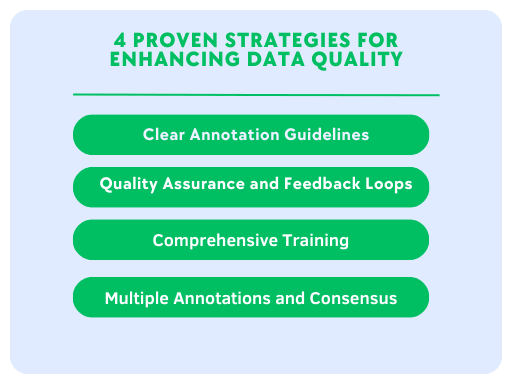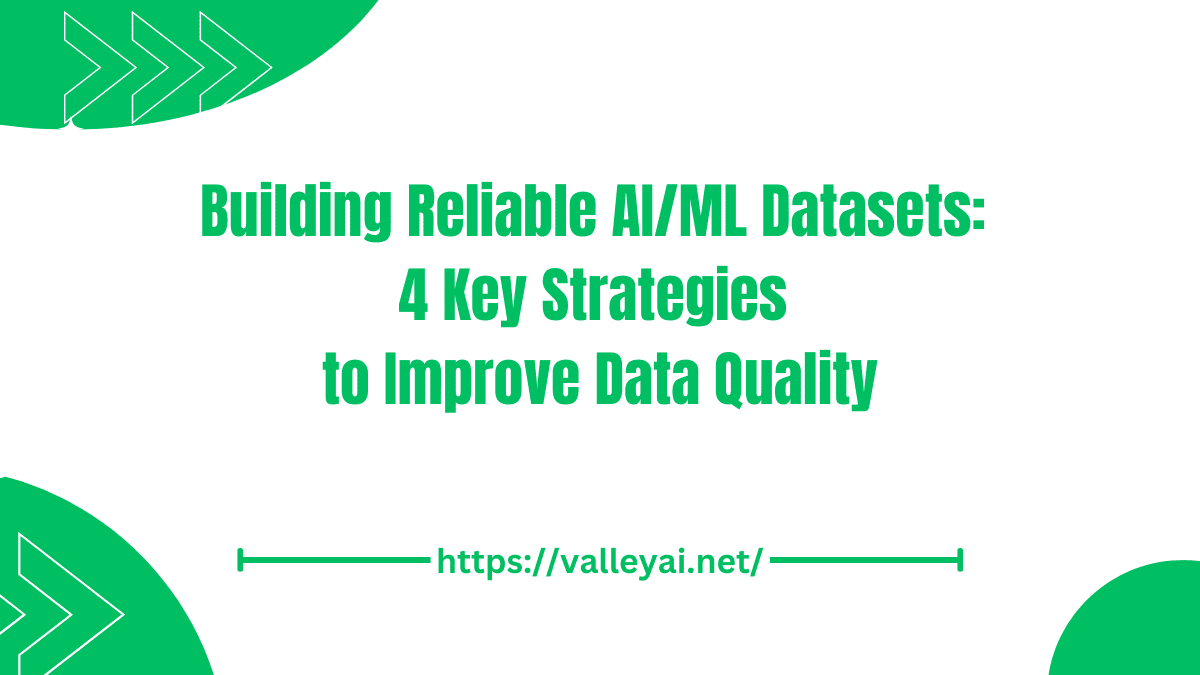Machine learning systems are hungry for data. But, feed them inaccurate or inappropriate data, and they will fail spectacularly. For instance, training an AI/ML solution for self-driving vehicles with mislabeled traffic light images (Red is Go, Green is Stop) will cause a disaster.
The key is a high-quality training dataset, annotated with proper labels, that can enable the AI/ML model to learn the right information and generate relevant responses. This can be ensured through careful and rigorous data annotation.
However, as stated earlier, low-quality datasets can produce undesirable results and affect the models’ performance. Let’s delve deeper into these issues.
The Pitfalls of Low Quality Training Datasets on AI/ML Solutions
It’s important to recognize the problem before working on the solutions. Therefore, let’s understand how poor data quality is a roadblock to achieving successful ML outcomes.
Non-uniform Training Datasets
Uniformity and consistency are crucial to producing high-quality datasets. When annotators fail to adhere to pre-defined guidelines, it leads to inconsistent annotations. This negatively affects the performance of ML models, making it challenging to generate reliable predictions.
Insufficient Annotation Coverage
In certain situations, poor-quality data may lack sufficient coverage across different data points or scenarios. This limited coverage in the training data can hinder the machine learning model’s ability to generalize and handle unfamiliar or difficult situations.
Scalability Issues
If the data is poorly organized, labeled, or documented, it becomes difficult to scale annotation efforts efficiently. This can result in delays, increased costs, and difficulties in maintaining consistency across a large dataset.
Bias and Subjectivity
Data annotators may unintentionally incorporate their personal biases or assumptions into the datasets. This can lead to machine learning models making unfair or discriminatory predictions, thus hampering the overall purpose of labeling.
In addition, lack of expertise, noisy annotation (mislabeling, incomplete, ambiguous, or outliers), or insufficient annotation depth also contribute to the adverse effects caused by inaccurate data.
However, it is important to work on data quality to mitigate these and attain sophisticated and robust training datasets. Here are a few quality controls that organizations can implement to facilitate the most accurate and consistent data annotation process.
Maximizing AI/ML Impact: 4 Proven Strategies for Enhancing Data Quality

Clear Annotation Guidelines
Let’s say you’re creating a dataset to train the machine learning model to classify images of animals. Without clear guidelines, one annotator may label a picture of a cat as “feline” while another may label it as “house cat.” This inconsistency in labeling can lead to confusion in the dataset.
With clear annotation guidelines, you can provide standard instructions (to the data annotation team) such as “label all domestic cats as ‘house cats’ and classify them under the category ‘feline.’ ” This clarity ensures that all annotators follow the same guidelines, leading to consistent annotations across the dataset.
By addressing potential edge cases and providing illustrative examples, the guidelines help maintain accuracy and ensure all relevant information is captured during the annotation process.
Quality Assurance and Feedback Loops
Let’s say you’re building a sentiment analysis model and have a team of annotators labeling customer reviews as positive, negative, or neutral. To ensure accuracy, you can implement a quality assurance process that involves professional reviewers checking accuracy, consistency, and guideline adherence in annotated data.
They can conduct rigorous checks, identify mistakes, and provide detailed feedback to annotators, helping them improve. If a negative review is incorrectly labeled as positive, they can highlight the error and guide them accordingly.
Annotators can incorporate feedback and align it with the guidelines to enhance accuracy. This iterative feedback loop can continue throughout the annotation process, resulting in high-quality datasets and achieving the desired AI/ML performance.
Comprehensive Training
To ensure high-quality data annotation, it is essential to train your annotators with the guidelines, tools, quality control measures, and best practices. Additionally, if the annotation task involves domain-specific data, annotators should receive training on relevant domain knowledge, including terminology, context, and common patterns.
Practical exercises and real-world examples should be incorporated into the training to help annotators apply the guidelines effectively. These exercises can involve annotating sample data, discussing edge cases, and addressing common annotation challenges.
By providing in-depth training, annotators will be well-versed with the necessary skills to perform high-quality data annotation and create accurate datasets. Since training requires a significant investment of time and resources, you can always partner with a trusted data labeling company that has a team of subject matter experts. Therefore, you will end up saving costs and the time required for training and managing an in-house team.
Multiple Annotations and Consensus
Let’s say you are working on a project that involves identifying objects in images. You have a set of images that need to be annotated with labels such as “vehicle,” “tree,” or “person.” To ensure accuracy, you assign three annotators to label each image independently.
Now there are chances of discrepancies or disagreements, wherein in one image, annotator A-labels a vehicle as a “bus,” while annotators B and C label it as a “school bus.” This discrepancy suggests ambiguity in the guidelines or potential confusion among the annotators.
To resolve such disagreements, implementing consensus – a robust mechanism based on label scores – is essential. Here, annotators can assign scores to each label and select the label with the highest score. The scores represent the agreement level among multiple annotators for the same data point.
By prioritizing labels with higher agreement scores, the model will resolve disagreements and ensure accuracy. This approach improves the annotated data’s quality, leading to better machine-learning model performance with reduced bias.
What’s Next?
Data annotation is a resource-intensive task that requires significant time, effort, and expertise. Without proper guidance, collaboration, and training, datasets may not meet expectations, leading to adverse effects on AI/ML model performance. Here’s what you can do:
- Train your in-house team, or
- Hire freelance annotators, or
- Partner with a data annotation company
Consider your needs and choose the option that allows you to maximize time and cost savings while achieving optimal results. Prioritize efficiency and effectiveness when making your decision.
Concluding Note
The significance of high-quality data cannot be overstated when it comes to training AI/ML models. By prioritizing data quality, businesses can ensure that their AI models are reliable and capable of delivering meaningful outcomes.
By conducting thorough training sessions, establishing precise annotation guidelines, implementing stringent quality checks, and incorporating consensus among annotators, the occurrence of errors in annotation projects can be significantly minimized, leading to the creation of refined datasets.
However, it is important to acknowledge that this can be a challenging undertaking. Therefore, an alternative approach is to leverage data annotation services from affordable vendors, allowing you to focus on revenue-generating tasks while ensuring the quality of annotated data.
- Understanding the Landscape of Cloud Vulnerability Management - March 25, 2024
- Quality Assurance Strategies for Startups: Ensuring Software Reliability - March 5, 2024
- Working of NLP to Improve Copywriting in AI Paraphrasing Tool - February 28, 2024

